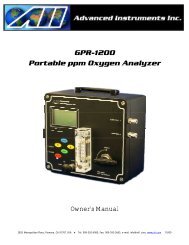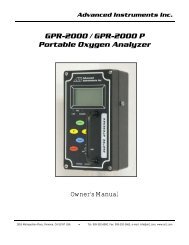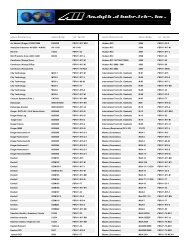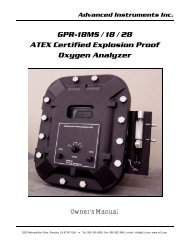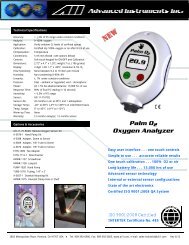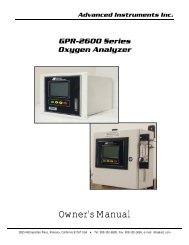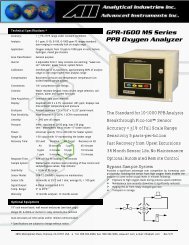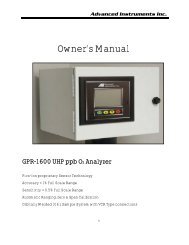GPR-1800 AIS ATEX Trace PPM Oxygen Analyzer - Advanced ...
GPR-1800 AIS ATEX Trace PPM Oxygen Analyzer - Advanced ...
GPR-1800 AIS ATEX Trace PPM Oxygen Analyzer - Advanced ...
- No tags were found...
Create successful ePaper yourself
Turn your PDF publications into a flip-book with our unique Google optimized e-Paper software.
<strong>Advanced</strong> Instruments Inc.Application Pressure - Atmospheric or Slightly Negative: For accurate ppm range oxygen measurements, an optionalexternal sampling pump should be positioned downstream of the sensor to draw the sample from the process, by the sensorand out to atmosphere. A flow meter is generally not necessary to obtain the recommended flow rate with most samplingpumps.Caution: If the transmitter is equipped with an optional flow indicator with integral metering valve or a metering flow controlvalve upstream of the sensor - open the metering valve completely to avoid drawing a vacuum on the sensor and placing anundue burden on the pump.If pump loading is a consideration, a second throttle valve on the pump’s inlet side may be necessary to provide a bypass pathso the sample flow rate is within the above parameters.Recommendations to avoid erroneous oxygen readings and damaging the sensor:‣ Do not place your finger over the vent (it pressurizes the sensor) to test the flow indicator when gas is flowing to thesensor. Removing your finger (the restriction) generates a vacuum on the sensor and may damage the sensor (voiding thesensor warranty).‣ Assure there are no restrictions in the sample or vent lines‣ Avoid drawing a vacuum that exceeds 14” of water column pressure – unless done gradually‣ Avoid excessive flow rates above 5 SCFH which generate backpressure on the sensor.‣ Avoid sudden releases of backpressure that can severely damage the sensor.‣ Avoid the collection of liquids or particulates on the sensor, they block the diffusion of oxygen into the sensor.‣ If the transmitter is equipped with an optional integral sampling pump (positioned downstream of the sensor) and a flowcontrol metering valve (positioned upstream of the sensor), completely open the flow control metering valve to avoiddrawing a vacuum on the sensor and placing an undue burden on the pump.Moisture & Particulates: Installation of a suitable coalescing or particulate filter is required to remove condensation, moistureand/or particulates from the sample gas to prevent erroneous analysis readings and damage to the sensor or optionalcomponents. Moisture and/or particulates do not necessarily damage the sensor, however, collection on the sensing surfacecan block or inhibit the diffusion of sample gas into the sensor resulting in a reduction of sensor signal output – and theappearance of a sensor failure when in fact the problem is easily remedied by blowing on the front of the sensor. Consult thefactory for recommendations concerning the proper selection and installation of components.Gas Connections: Inlet and outlet vent gas lines for ppm analysis require 1/8” or ¼” stainless steel compression fittings; hardplastic tubing with a low permeability factor can be used percentage range measurements.Power Connection: Locate the appropriate power source to meet the analyzer or transmitter requirements, ensure that isproperly grounded and meets the area classification.Mounting the TransmitterThe <strong>GPR</strong>-<strong>1800</strong><strong>AIS</strong> consists of two interconnected enclosures (without the optionalsample conditioning system and panel) and measures 8”H x 15-3/4”W x 7”D. Thisconfiguration is designed to be mounted directly to any flat vertical surface, wall orbulkhead plate with eight (8) of the appropriate screws. To facilitate servicing theinterior of the transmitters, position it approximately 5 feet off ground level.Remove the four (4) screws securing the top section of the enclosure, set themaside for reinstallation and raise the hinged top section 180º until it locks in place.Locate the mounting holes cast into the enclosure.Secure the enclosure to a vertical surface approximately 5 feet from the floor or a level accessible to service personnel. Thisrequires the user to supply four (4) additional proper size screws and anchors.Caution: Do not remove or discard the gaskets from either the enclosure or junction box. Failure to reinstall either gasket willvoid the NEMA 4 rating and RFI protection. The transmitters design provides protection from RFI that is maintained by leavingspecific mating areas of the enclosure unpainted to maintain conductivity the gasket, top and bottom sections of the enclosure.11



